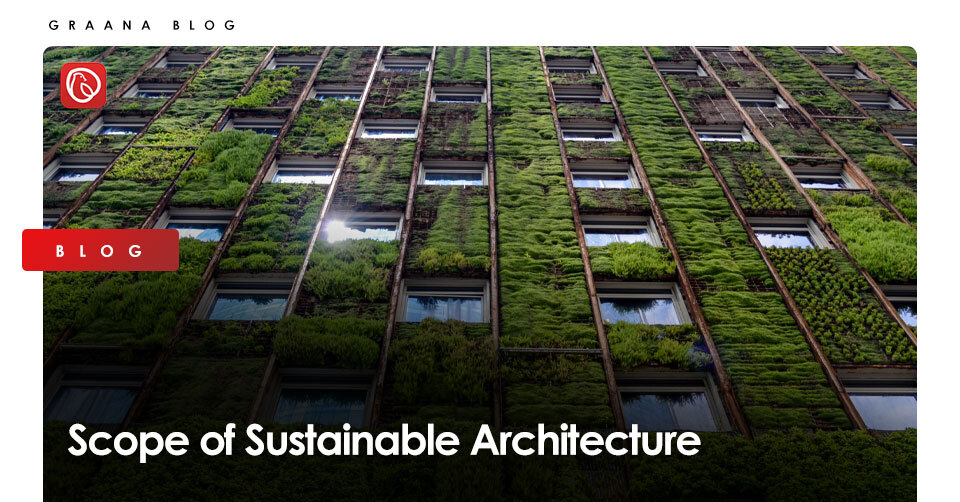
As we grow more conscious of the importance of environmental issues, there is one aspect of our life where sustainability is more important than ever. And that is how the places in which we live are developed. The building sector, which is heavily reliant on natural resources, has no choice but to consider sustainability. Sustainability has become a catchphrase in a number of businesses. Given that construction is a significant source of global energy consumption, it’s no wonder that scope of sustainable architecture is expanding in the design of buildings and towns.
Sustainable methods must now be integrated into every step of the design process, rather than being thrown on as an afterthought. It is required by both the end-user and the environment. Graana.com, smartest real estate portal, brings you all you need to know about the scope of sustainable architecture.
While settlements continue to grow, the Earth itself remains unchanged. This expansion has a significant environmental impact because the process of creating new habitats for our communities consumes a significant portion of our natural resources. The Earth is not an inexhaustible reservoir that can be renewed at the same rate as industrialization.
Architects are now required not simply to create designs that are beautiful and functional, but also to come up with integrated solutions that include environmental considerations.
Sustainable architecture is the concept of developing buildings that have the least environmental impact. It involves the production and careful maintenance of a healthy physical environment based on resource-efficient and environmental principles. Through energy-efficient technologies, sustainably built buildings attempt to curb ecological footprint. They aim to reduce the use of nonrenewable resources or harmful materials and enhance the natural environment.
Sustainable architecture takes into account the site’s natural resources and environmental circumstances. It is also called Green architecture. It pushes architects, designers, and developers to create smart solutions and uses modern techniques to ensure that constructions have the least amount of negative impact on the environment and communities.
Construction projects often utilize a significant amount of materials and generate a lot of waste.
There is a constant challenge in the architecture of balancing the urge to develop newer, more modern designs against preserving historical buildings.
A sustainable building is a building that has the lowest deleterious repercussions on the built and natural environments. It has the least adverse impact on surroundings in close proximity and then eventually on the larger regional and global environments. Efficient use of natural resources and proper building stock management in sustainable architecture helps to limit use of resources, reduce energy consumption, and improve environmental quality.
The materials, construction methods, resource consumption, and overall design of a building all contribute to its sustainability. The sustainable architecture design must also allow for long-term functioning throughout the building’s life cycle, including demolition. It improves the health of building inhabitants while also lowering the negative environmental effects of the construction process.
All of a smart building’s water and energy requirements can be met on-site. It can be tailored to the climate of the site and evolve as conditions change. Furthermore, as a healthy environment does, it promotes the health and well-being of all residents.
By maintaining existing ecosystems, biodiversity and minimizing CO2 emissions, sustainable architecture lessens the harmful consequences of development on the environment. It achieves this by protecting existing habitats, planting trees around a new construction site, and choosing sustainable materials to lower a building’s carbon footprint.
Sustainable architecture limits energy use and reduces waste by employing methods like solar energy sources, centralizing water and heating distribution systems, and using renewable materials.
Sustainable architecture takes into consideration the factors affecting the natural ecosystem. It tries to minimize the disruption caused to environment and immediate areas. Protection of the habitat of all living beings is one of the major concerns of designers implementing sustainable design.
Investing in sustainable architecture might cost more at first but the investment definitely outweighs the advantages and pays back in the long run. It reduces the dependence on traditional energy resources and maintenance costs.
Sustainable real estate properties have a better investment value than conventional buildings as they have a higher return on investment. Buildings with better environmental credentials command higher rents, lower depreciation, and higher tenant satisfaction.
Sustainable architecture in buildings provides them with a competitive edge over other properties. With sustainability being a concern for buyers of today, sustainably built properties will always have a competitive advantage. Modern buyers will always look for choices that are environmentally friendly and energy efficient.
Sustainable architecture provides improved air quality. It avoids using building materials that contain dangerous VOCs or plastic by-products, both of which have been linked to the release of poisonous gases and carcinogens into the air. These hazardous compounds have been related to respiratory disease, allergies, and other health problems.
Due to increased air quality, residents of sustainable buildings often have better overall health. Environmentally sustainable architecture benefits people’s overall health. Healthy structures encourage healthy lifestyles. Because of the environmentally friendly materials used in buildings, people who live in sustainable buildings enjoy numerous health benefits. Being in the presence of sustainable, natural materials improves feelings of well-being and happiness.
To effectively maximize these benefits, architects and builders must take a 360-degree approach to environmental considerations throughout the design and construction process. Sustainable architecture promises a future-focused approach that is beneficial for us and the planet.
For more information visit Graana Blog
ISLAMABAD, Pakistan – April 23, 2025 – Chaaye Khana, Pakistan's popular cafe renowned for its…
ISLAMABAD: Prime Minister Shehbaz Sharif laid the foundation stone for the Murree Road underpass on…
DUBAI: Pakistani real estate developers and representatives showcased a range of commercial and residential investment…
ISLAMABAD: Capital Development Authority (CDA) is currently undertaking a major Rs652 million project to upgrade…
Karachi – Mayor Barrister Murtaza Wahab has announced the launch of a citywide anti-encroachment operation…
ISLAMABAD: CDA Chairman Muhammad Ali Randhawa has directed the immediate restoration of 23 non-functional water…